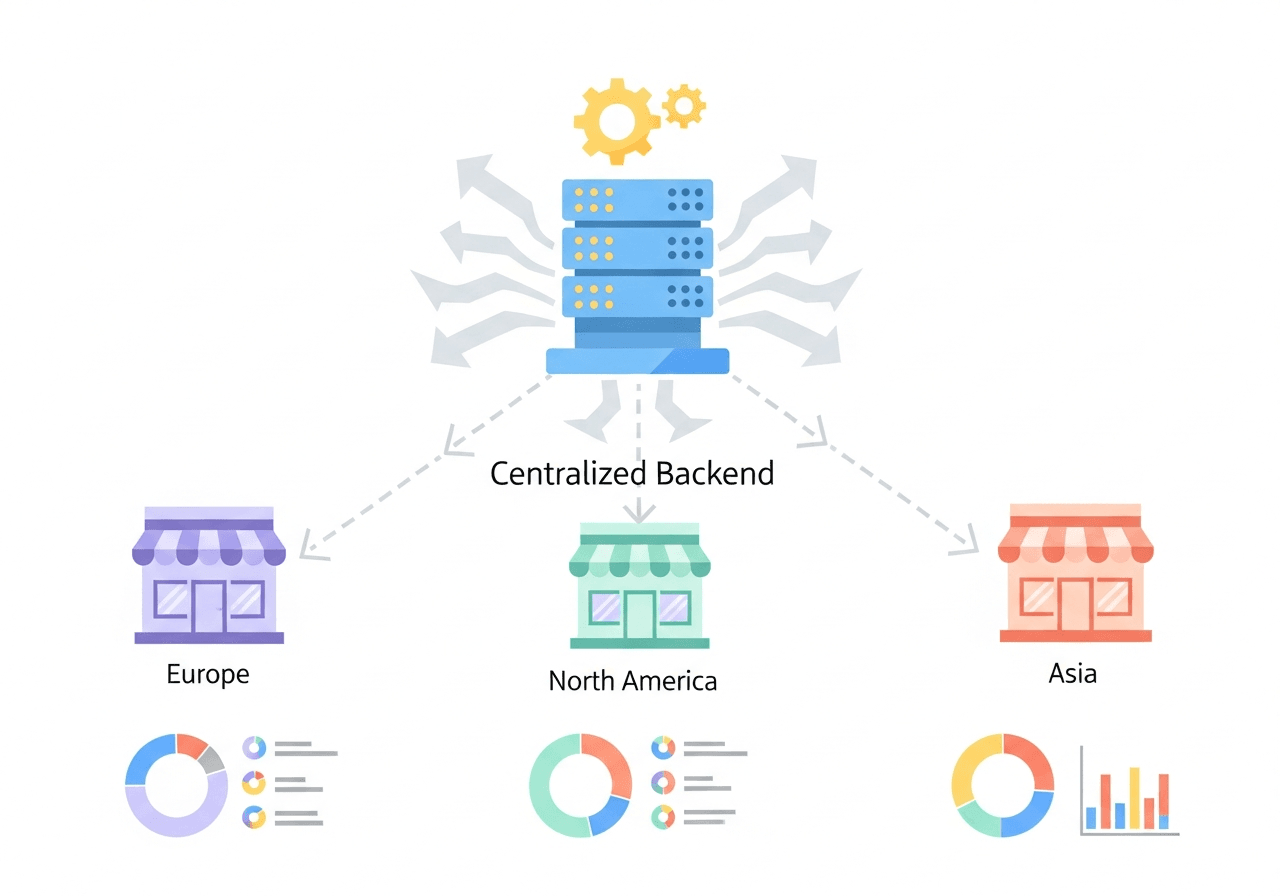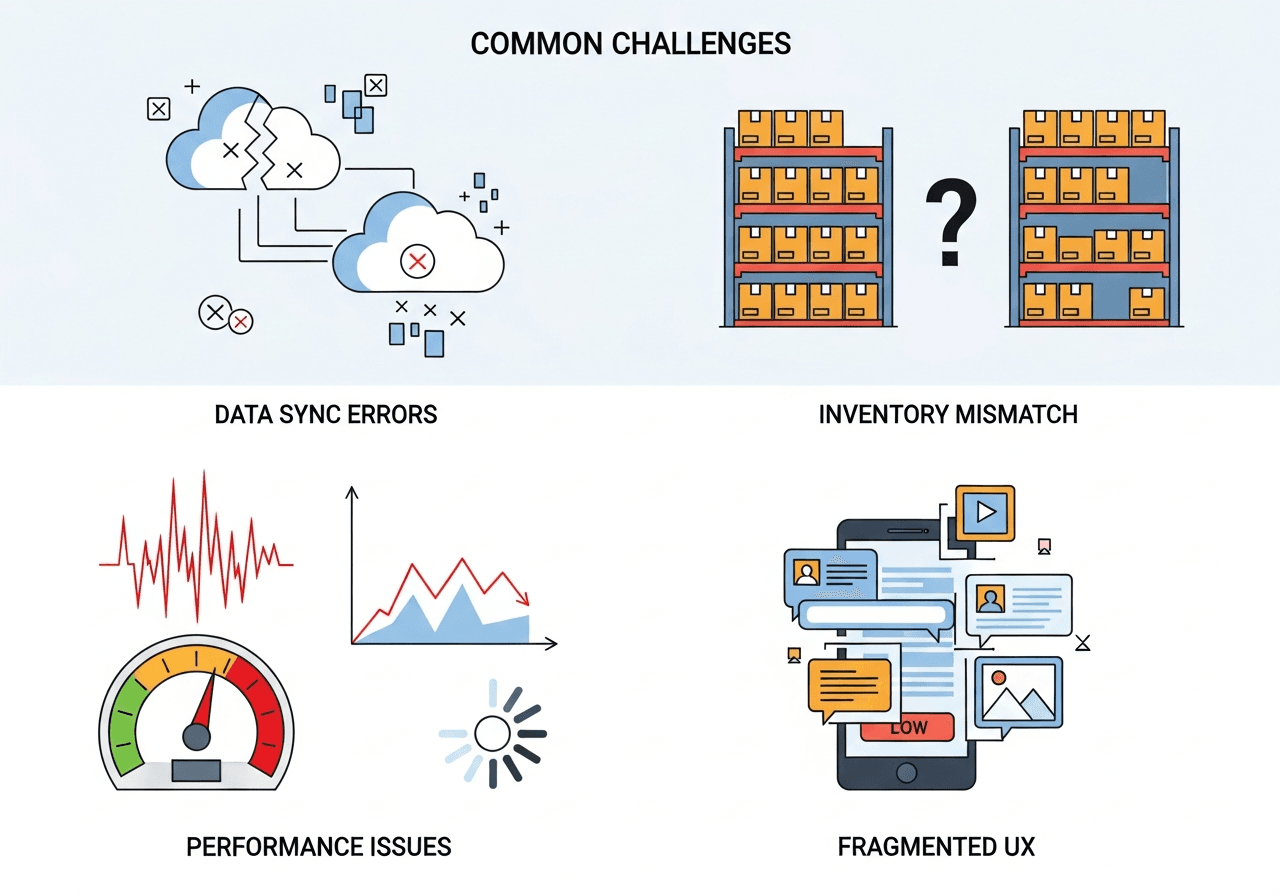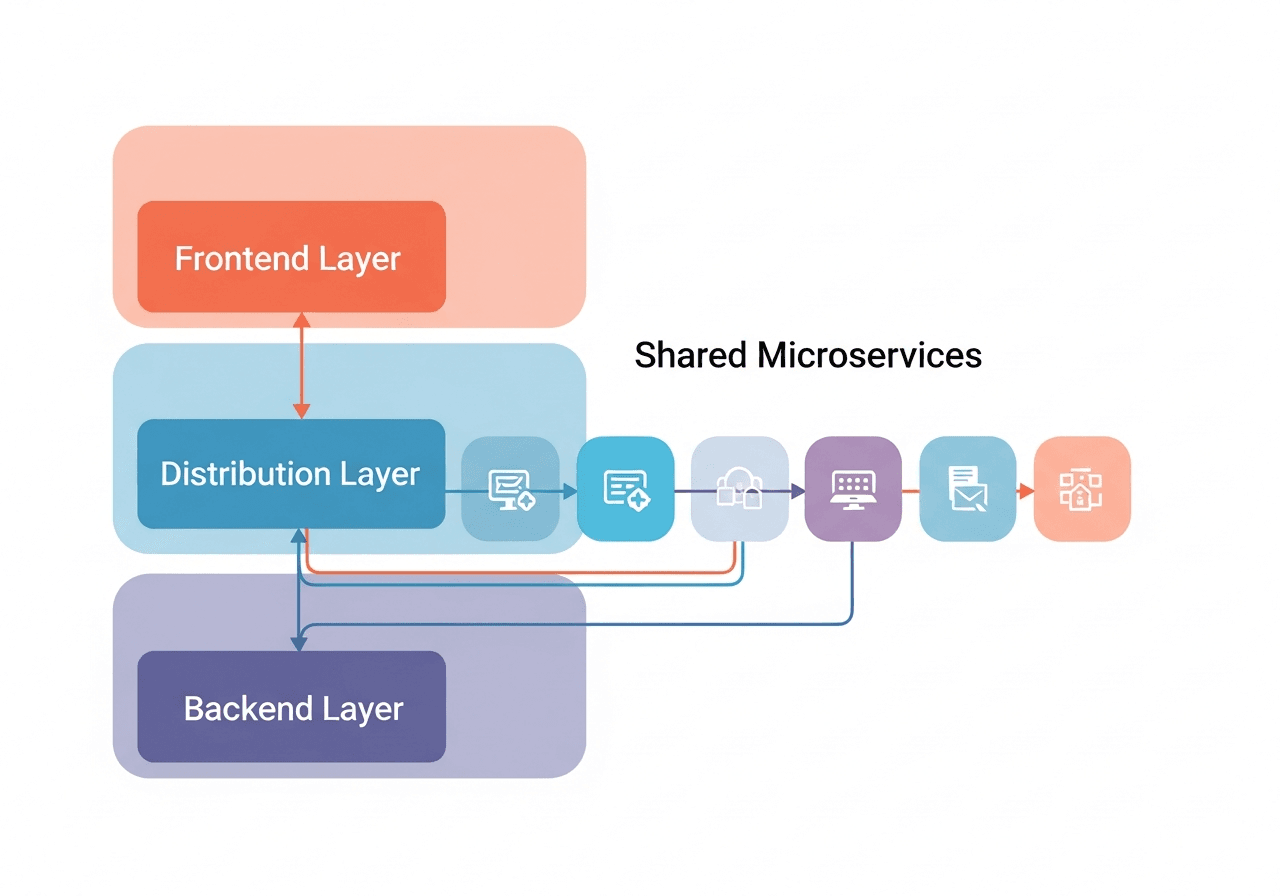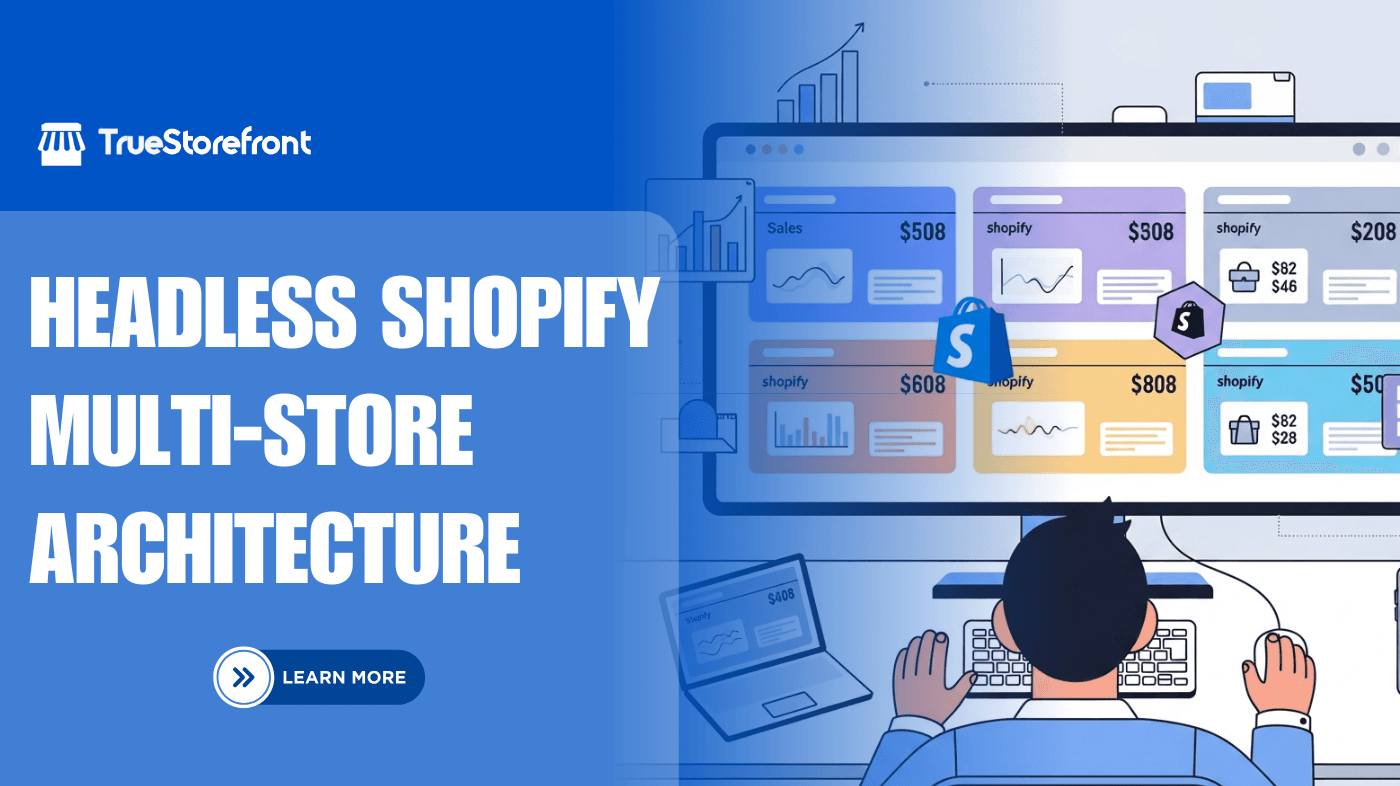Managing multiple ecommerce stores is no longer just a challenge for large enterprises. As brands expand across regions, languages, and product lines, the need for multi-store management becomes increasingly essential. Shopify’s headless architecture enables merchants to operate multiple storefronts while maintaining one centralized backend, delivering unparalleled flexibility and operational efficiency.
However, managing multiple Shopify headless stores requires strategic planning, a robust technical foundation, and clearly defined workflows. This guide explores best practices, architectural principles, and operational tips to help businesses manage a headless Shopify multi-store system effectively and sustainably.
I. Why Brands Choose Headless Shopify for Multi-Store Operations

Centralized Backend, Unlimited Frontends
Headless commerce decouples the backend from the frontend. This gives businesses the freedom to create multiple storefronts—each with its own design, language, product assortment, or customer experience—while relying on a single backend for product data, inventory, pricing, and checkout logic.
Faster Global Expansion
Brands operating in multiple regions must adjust currency, fulfillment rules, and marketing approaches. With headless Shopify multi-store architecture:
- Regional stores can share the same backend product catalogue.
- Country-specific frontends can be customized without affecting others.
- Localization becomes easier and more scalable.
Consistent Brand Experience Across Channels
Because each storefront is built independently, businesses can tailor the UX for mobile apps, web apps, kiosks, marketplaces, or even IoT devices—while maintaining brand consistency at the backend level.
II. Core Principles of Headless Shopify Multi-Store Architecture
A successful multi-store architecture requires a clear understanding of how your storefronts communicate with Shopify. Below are essential components to consider.
Single Source of Truth (SSOT)
All product data, inventory, and pricing should originate from one central backend. This minimizes errors, avoids data conflicts, and ensures consistent information across all storefronts.
API-First Distribution Layer
Shopify storefront API, Admin API, and third-party orchestration tools act as the distribution layer for:
- Product data
- Customer profiles
- Discounts
- Inventory
- Checkout sessions
This API-first design ensures that each storefront receives exactly the content and configuration it needs.
Modular Frontend Development
Each frontend should maintain independent codebases, allowing teams to iterate faster while ensuring tailored UX for different audiences. Examples of frontend stacks include:
- Hydrogen + Remix
- Next.js
- Nuxt
- React Native (mobile)
Shared Microservices
For multi-store setups, shared services improve consistency and reduce duplicated effort. Common microservices include:
- Authentication
- Payment gateway integration
- Search & filtering
- Product recommendations
- Analytics
III. Key Challenges in Managing Multiple Headless Stores

Although powerful, managing multiple Shopify headless stores can introduce complexities:
Data Synchronization: Keeping product data standardized across stores requires synchronization workflows and automated data pipelines.
Multi-Region Inventory Management: Variations in stock availability across regions can lead to overselling if not carefully managed.
Performance Optimization: Each storefront may require its own performance tuning and CDN strategy, especially when targeting multiple countries.
Maintaining Consistency Across Codebases: Without proper governance, frontend teams can produce fragmented user experiences.
IV. Strategies for Efficient Multi-Store Management
4.1 Establish a Unified Product Information Management System (PIM)
A PIM allows businesses to manage product data centrally and distribute it to various storefronts. This significantly reduces manual data entry and ensures accuracy.
Benefits:
- Faster product updates
- Reduced human error
- Structured, scalable catalog management
Automate Content and Data Deployment
Automation reduces operational overhead and helps maintain consistency across stores.
Recommended tools include:
- CI/CD pipelines (GitHub Actions, GitLab CI)
- Webhooks
- Storefront API automations
Automation ensures that updates flow smoothly across all storefronts without manual intervention.
4.3 Implement a Multi-Region CDN Strategy
Having multiple storefronts means traffic originates from different parts of the world. Using a CDN ensures global customers receive fast page loads.
Hydrogen hosting, Vercel, Netlify, or Cloudflare Pages are ideal for headless storefronts.
4.4 Use Centralized Authentication and Customer Management
Managing customer profiles across multiple stores can become a nightmare. Using a shared authentication service ensures:
- Unified login experience
- Cross-store customer recognition
- Centralized customer analytics
4.5 Shared Design System and Component Library
Creating a global UI library allows teams to maintain consistent branding and reduces duplicated coding efforts across storefronts.
Tools to consider:
- Storybook
- Figma libraries
- Tailwind component systems
4.6 Regional Personalization
Each store should feel tailored for its intended audience, even when sharing the same backend.
Customizations may include:
- Local currencies
- Local languages
- Local promotions
- Payment methods
- Tax configurations
4.7 Orchestrate Workflows Through Composable Services
A composable commerce approach allows organizations to plug in services as needed. No more monolithic systems.
Common tools:
- Algolia for search
- Contentful or Sanity for content
- Klaviyo for marketing automation
- TaxJar or Avalara for tax
Composable commerce makes multi-store operations more flexible and easier to scale.
V. Technical Architecture Example for Headless Shopify Multi-Store

Below is a simplified model that many high-growth brands use:
Backend Layer (Shared Across All Stores)
- Shopify Admin
- Product Catalog
- Inventory Management
- Pricing Rules
- Customer profiles
- Order processing
Distribution Layer*
- Storefront API
- Admin API
- PIM system
- CMS
Frontend Layer (Separate for Each Store)
- Store A (Europe)
- Store B (North America)
- Store C (Asia-Pacific)
- Mobile App
- Marketplace Storefront
Shared Microservices
- Authentication
- Search
- Analytics
- Payments
- Notification services
VI. Best Practices for Long-Term Multi-Store Sustainability
Create Detailed Documentation: Multi-store systems involve complex workflows. Comprehensive documentation helps onboard new developers and ensures consistency.
Version-Control Storefront APIs: API changes should be versioned to avoid breaking multiple storefronts simultaneously.
Monitor Storefront Performance Separately: Each store has its own audience, device behavior, and traffic peaks.
Use tools like:
- Vercel Analytics
- New Relic
- Google Lighthouse
- Cloudflare Analytics
Establish Governance Rules: A governance framework ensures teams follow consistent coding standards, API usage, and UI patterns.
Periodic Architecture Audits: Annual or biannual audits help uncover inefficiencies and allow you to recalibrate your multi-store ecosystem.
VII. When Should You Consider a Multi-Store Headless Shopify Setup?
A multi-store setup is ideal for brands that:
- Operate in multiple countries
- Manage different product lines
- Sell to B2B and B2C audiences simultaneously
- Require unique storefront experiences
- Want complete design freedom
- Manage marketplace expansions
If your brand is scaling rapidly or preparing to enter new markets, headless multi-store Shopify architecture enables smooth expansion without compromising performance.
VIII. Conclusion: Unlock Efficiency with Headless Shopify Multi-Store Management
Shopify headless multi-store architecture gives businesses the flexibility to scale globally while maintaining efficient operations through a centralized backend. With the right combination of automation, shared microservices, unified product management, and strategic frontend development, brands can deliver consistent yet localized shopping experiences across every storefront.
As ecommerce becomes increasingly global, the ability to manage multiple headless stores efficiently will become a key competitive advantage. Now is the time to build scalable systems and workflows that support long-term growth.
Read more:
